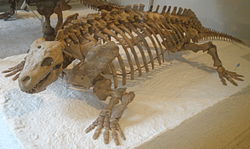Diadectomorpha
| Diadectomorphs Temporal range: Late Carboniferous–Wuchiapingian |
|
|---|---|
 |
|
| Skeleton of Diadectes sideropelicus in the American Museum of Natural History | |
| Scientific classification | |
| Kingdom: | Animalia |
| Phylum: | Chordata |
| Clade: | Reptiliomorpha |
| Order: |
†Diadectomorpha Watson, 1917 |
| Subgroups | |
Diadectomorpha are a clade of large reptile-like amphibians that lived in Euramerica during the Carboniferous and Early Permian periods and in Asia during Late Permian (Wuchiapingian), and are very close to the ancestry of the Amniota. They include both large (up to 2 meters long) carnivorous and even larger (to 3 meters) herbivorous forms, some semi-aquatic and others fully terrestrial. The Diadectomorpha seem to have evolved during late Mississippian times, although they only became common after the Carboniferous rainforest collapse and flourished during the Late Pennsylvanian and Early Permian periods.
Diadectomorphs possess both amphibian and reptilian characteristics. Originally these animals were included under the order Cotylosauria, and were considered the most primitive and ancestral lineage of reptiles. More recently they have been reclassified as amphibian-grade tetrapods, closely related to the first true amniotes. Contrary to other Reptiliomorph amphibians, the teeth of the Diadectomorpha lacked the infolding of the dentine and enamel that account for the name Labyrinthodontia for the non-amniote tetrapods.
...
Wikipedia
